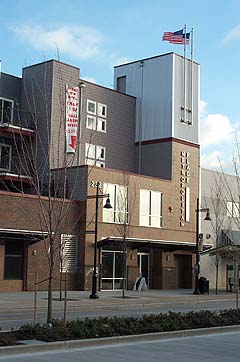
Surveys
DJC.COM
February 27, 2003
TODs: Look beyond the physical characteristics
Integrated Transport Research

Nelson |
Almost all trips, about 97 percent, are by private vehicle. And most are to scattered locations for nonwork purposes — shopping, eating out, recreation and personal business. Commuting to work accounts for just 20 percent of all trips, and work trips are often linked with nonwork trips.
But even as we enjoy the door-to-door convenience our vehicles provide, we complain about the downside, particularly the congestion that results when too many vehicles — those other guys — converge at the same time on roads with finite capacity.

Photo courtesy of TSA Architects
One of King County’s first transit-oriented developments was Metropolitan Place in Renton. It opened about a year ago with 90 apartments, commercial space and a Metro park-and-ride.
|
Politicians, planners and citizens have responded with remedies that range from increased roadway capacity, including HOV lanes, to fixed-guideway transit technologies that augment and replace bus transit. They also have attempted to change travel patterns through strategies that make land use and transit mutually supportive. Prominent among these is transit-oriented development or TOD.
TOD combines higher residential and employment densities with frequent transit service. It often involves increasing the mix of uses around stations so that more trips can be made on foot as well as by transit.
TOD has become a national paradigm as more cities and regions have opted to invest heavily in new transit capacity. And TOD is a chief tenant of our regional growth plan, Vision 2020, and county and city comprehensive plans.
Recently, TOD’s purported benefits have come under closer scrutiny by researchers. One study, sponsored by the Brookings Institution Center on Urban and Metropolitan Policy, concluded “the amount of hype around transit-oriented development far exceeds the progress to date, with many transit proponents selling new transit investments on the basis of land-use changes yet to come.”
Although much of the planning for TOD in our region has focused on station areas on light rail and commuter rail lines, one of the first completed projects, the Village at Overlake Station, involves a 308-unit low-income apartment building owned and managed by the King County Housing Authority over a park-and-ride lot next to a bus transit center. Residents are provided free bus passes to encourage use of transit.
Similar developments are in the offing at a number of other transit centers, both bus and rail, distributed around the region. This presents opportunities for developers who aren’t afraid to be challenged by novel and often-complex projects. Complexity arises because of numerous public policy goals, some conflicting, and multiple governmental stakeholders that need to be satisfied.
TOD’s success depends on ownership and the eye of the beholder. For single-parcel projects that involve public ownership, like Overlake, success equates to more efficient use of publicly owned land, and meeting the demand for affordable housing in a location that can reduce transportation costs for low-income citizens.
For larger TOD projects, such as rail station area redevelopment, ownership may be mixed. Success for private owners of residential buildings may be dependent on how well the TOD competes with other sites with investment potential. Some level of public subsidy may be needed to attract private capital and offset the need to provide rents that are affordable to the transit-dependent population.
For private developers and owners, TOD presents other issues that need careful consideration. Retail and service businesses often draw customers from market areas much larger than the station area, which is generally an area within a 5-minute walk of the transit station. So provision of adequate parking for customers that must drive to a commercial venue can collide with the public purpose of reducing auto travel and encouraging transit and walking trips.
The city of Seattle has taken the goal of using TOD to change travel behavior one big step further by adopting limits on land use in light rail station areas. Some “auto-dependent” uses — such as gas stations, businesses with drive-in windows such as banks and fast-food restaurants, mini-warehouses and vehicle repair shops — are forbidden. Thus the long-term use of property in a TOD experiences reduced flexibility.
The ostensible object of these higher levels of government intervention in the marketplace in support of TOD is to produce transportation benefits, principally in the form of a reduced number and length of auto trips, and attendant congestion. Improved urban livability and less sprawl are often mentioned as collateral public benefits.
Generally speaking, the public sector and not the private sector will be held accountable for the realization of these benefits and whether they are commensurate with the public costs, including transportation investments and developer subsidies. But the private development community should have an interest in the success of TOD investments since there may be alternative public investments that, even though more efficacious, will not be made, i.e. opportunity costs are real.
Net positive transportation benefits of TOD do not follow a priori. In our region, largely because of difficult topography, retrofitted fixed-guideway transit investment costs are high. And, because the region is already well served by bus transit, they do not generate substantial numbers of new transit users. Even when supported by more intensive, mixed-use station-area development, travel patterns on a regional scale are not greatly impacted.
This is evident from the population and land area estimates for the stations proposed for the original Link light rail line from the University District to Sea-Tac.
The Link alignment was chosen to serve the city’s most dense census tracts. Together, the 16 station areas within the city contain just 5 percent of the city’s population and 3 percent of the city’s land area. Although this is current population, the city’s growth patterns — most new housing is distributed across the city in commercial and multi-family zones along arterials — suggest that the fraction will not change. Outside the city, residential density falls off dramatically and station areas will encompass a smaller proportion of the suburban population.
For these reasons, TOD success needs to be defined and measured on the basis of scale. For an individual resident of a development such as the Village at Overlake who previously lived in a location where transit was not easily accessible or frequent, the transportation benefits can be positive. However, for the Overlake area itself, a highly auto-dependent commercial center, the traffic impacts will likely be too small to measure. And even if TOD is produced at multiple locations, including light rail stations, the impact on the 11 million trips per day may still be hard to discern.
The need for a better understanding of what TOD success means is supported by the Brookings study and research by this author. Both suggest that attention to functional outcomes is more important than the physical characteristics of the development.
Dick Nelson is a principal of Seattle-based Integrated Transport Research. His professional interests revolve around urban dynamics, including the nexus of transportation, land use and telecommunications. He has co-authored several studies of TOD.
Other Stories:
- Seattle’s economy: Out of sync?
- Insurance industry weathers a ‘perfect storm’
- Marketing homes during war
- Creating suburban living in the city
- Young blood takes on a challenging market
- Mortgages and technology: A Catch 22
- The moisture vs. energy code balancing act
- Colleges face big real estate challenges
- Cooking up a new business? Think incubator
- New laws needed to fight insurance crisis
- In Bellevue, holes aren’t the whole story
- Monorail expected to spark new development
- Affordable housing still GMA challenge
- Third time’s the charm for Lakewood retail
Copyright ©2009 Seattle Daily Journal and DJC.COM.
Comments? Questions? Contact us.